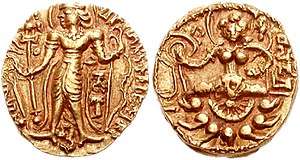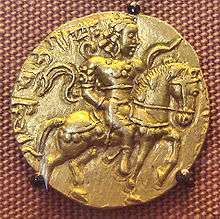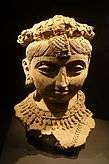Narasimhagupta
| Narasimhagupta | |
|---|---|
 Coin of Narasinhagupta I, Circa 414-455 CE.[1] | |
| 12th Gupta emperor | |
| Reign | c. 495 – c. 530 CE |
| Predecessor | Budhagupta |
| Successor | Kumaragupta III |
| Spouse | Shrimitradevi |
| Dynasty | Gupta |
| Father | Purugupta |
| Religion | Hinduism |
| Gupta Empire 320 CE–550 CE | ||||||||||||||||||||||||||||||||||||
|---|---|---|---|---|---|---|---|---|---|---|---|---|---|---|---|---|---|---|---|---|---|---|---|---|---|---|---|---|---|---|---|---|---|---|---|---|
|
||||||||||||||||||||||||||||||||||||
Narasimhagupta Baladitya was an emperor of the Gupta Empire of North India. He was son of Purugupta and probably the successor of Budhagupta.
Defeat of the Hunas
Baladitya along with Yasodharman of Malwa is credited with driving the Alchon Huns from the plains of North India according to the Chinese monk Xuanzang.[2] In a fanciful account, Xuanzang, who wrote a century later in 630 CE, reported that Mihirakula had conquered all India except for an island where the king of Magadha named Balditya (who could be Gupta ruler Narasimhagupta Baladitya) took refuge, but that Mihirakula was finally captured by the Indian king, who later spared his life. Mihirakula is then said to have returned to Kashmir to retake the throne.[3][4]
Narasimhagupta's governor in Malwa, Bhanugupta may also have been involved in this conflict.
Buddhism
The Guptas were traditionally a Brahmanical dynasty.[5] Narasimhagupta Baladitya however, according to contemporary writer Paramartha, was brought up under the influence of the Mahayanist philosopher, Vasubandhu.[5] He built a sangharama at Nalanda and also a 300 ft (91 m) high vihara with a Buddha statue within which, according to Xuanzang, resembled the "great Vihara built under the Bodhi tree". According to the Manjushrimulakalpa (c. 800 CE), king Narasimhsagupta became a Buddhist monk, and left the world through meditation (Dhyana).[5]
The Chinese monk Xuanzang also noted that Baladitya's son, Vajra, who commissioned a sangharama as well, "possessed a heart firm in faith".[6]:45[7]:330
His clay sealing has been found in Nalanda. The name of his queen mentioned in the Nalanda sealing is Shrimitradevi. He was succeeded by his son Kumaragupta III.
Coinage
 Coin of Narasimhagupta Baladitya, circa 495-530 CE.
Coin of Narasimhagupta Baladitya, circa 495-530 CE. Nalanda clay seals of Narasimhagupta.
Nalanda clay seals of Narasimhagupta.
References
- ↑ CNG Coins
- ↑ Malwa Through the Ages, from the Earliest Times to 1305 A.D, Kailash Chand Jain p.249
- ↑ Rise and Fall of the Imperial Guptas by Ashvini Agrawal p.245
- ↑ Early Buddhist Transmission and Trade Networks by Jason Neelis p.168
- 1 2 3 A History of Ancient and Early Medieval India by Upinder Singh p.521
- ↑ Sankalia, Hasmukhlal Dhirajlal (1934). The University of Nālandā. B. G. Paul & co.
- ↑ Sukumar Dutt (1988) [First published in 1962]. Buddhist Monks And Monasteries of India: Their History And Contribution To Indian Culture. George Allen and Unwin Ltd, London. ISBN 81-208-0498-8.
Sources
- Mookerji, Radhakumud (1995). The Gupta Empire. Delhi: Motilal Banarsidass. p. 119. ISBN 9788120804401.
| Regnal titles | ||
|---|---|---|
| Preceded by Budhagupta |
Gupta emperor 495 – ? |
Succeeded by Kumaragupta III |

